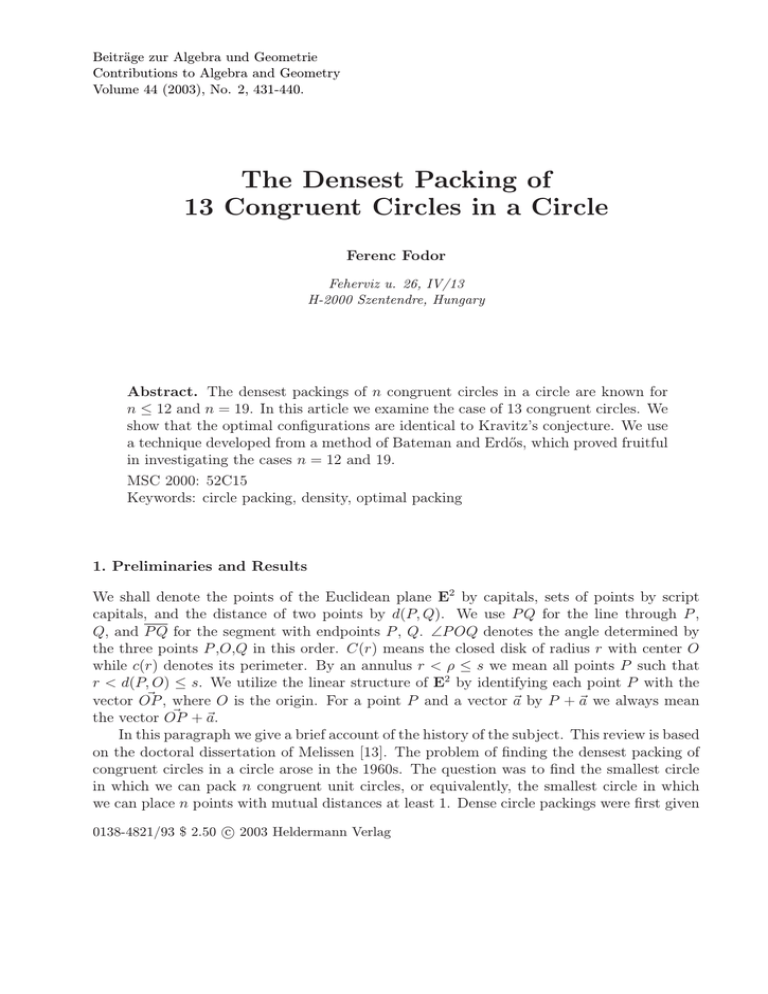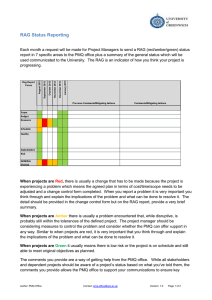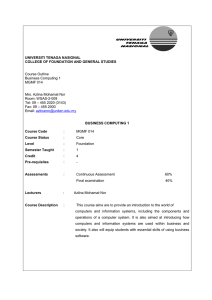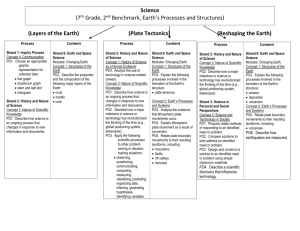Beitr¨ age zur Algebra und Geometrie Contributions to Algebra and Geometry
advertisement

Beiträge zur Algebra und Geometrie
Contributions to Algebra and Geometry
Volume 44 (2003), No. 2, 431-440.
The Densest Packing of
13 Congruent Circles in a Circle
Ferenc Fodor
Feherviz u. 26, IV/13
H-2000 Szentendre, Hungary
Abstract. The densest packings of n congruent circles in a circle are known for
n ≤ 12 and n = 19. In this article we examine the case of 13 congruent circles. We
show that the optimal configurations are identical to Kravitz’s conjecture. We use
a technique developed from a method of Bateman and Erdős, which proved fruitful
in investigating the cases n = 12 and 19.
MSC 2000: 52C15
Keywords: circle packing, density, optimal packing
1. Preliminaries and Results
We shall denote the points of the Euclidean plane E2 by capitals, sets of points by script
capitals, and the distance of two points by d(P, Q). We use P Q for the line through P ,
Q, and P Q for the segment with endpoints P , Q. ∠P OQ denotes the angle determined by
the three points P ,O,Q in this order. C(r) means the closed disk of radius r with center O
while c(r) denotes its perimeter. By an annulus r < ρ ≤ s we mean all points P such that
r < d(P, O) ≤ s. We utilize the linear structure of E2 by identifying each point P with the
~ , where O is the origin. For a point P and a vector ~a by P + ~a we always mean
vector OP
~ + ~a.
the vector OP
In this paragraph we give a brief account of the history of the subject. This review is based
on the doctoral dissertation of Melissen [13]. The problem of finding the densest packing of
congruent circles in a circle arose in the 1960s. The question was to find the smallest circle
in which we can pack n congruent unit circles, or equivalently, the smallest circle in which
we can place n points with mutual distances at least 1. Dense circle packings were first given
c 2003 Heldermann Verlag
0138-4821/93 $ 2.50 432
Ferenc Fodor: The Densest Packing of 13 Congruent Circles in a Circle
by Kravitz [11] for n = 2, . . . , 16. Pirl [14] proved that these arrangements are optimal for
n ≤ 9 and he also found the optimal configuration for n = 10. Pirl also conjectured dense
configurations for 11 ≤ n ≤ 19. For n ≤ 6 proofs were given independently by Graham [3].
A proof for n = 6 and 7 was also given by Crilly and Suen [4]. Later, improvements were
presented by Goldberg [8] for n = 14, 16, and 17. He also found a new packing with 20 circles.
In 1975 Reis [15] used a mechanical argument to generate good packings up to 25 circles.
Recently, Graham et al. [9, 10], using computers, established packings with more than 100
circles and improved the packing of 25 circles. In 1994 Melissen [12] proved Pirl’s conjecture
for n = 11 and the author [6, 7] proved it for n = 19 and n = 12. The problem of finding the
densest packing of equal circles in a circle is also mentioned as an unsolved problem in the
book of Croft, Falconer and Guy [5]. Packings of congruent circles in the hyperbolic plane
were treated by K. Bezdek [2]. Analogous results of packing n equal circles in an equilateral
triangle and square can be traced down in the doctoral dissertation of Melissen [13].
In this article we shall find the optimal configurations for n = 13. We shall prove the
following theorem.
Theorem 1. The radius of the smallest circle
√ in which we can pack 13 points with mutual
1+ 5
◦ −1
distances at least 1 is r13 = (2 sin 36 ) = 2 . The 13 points in C(r13 ) must form one of
the configurations shown in Figure 1.
Figure 1. The optimal configurations for n = 13
In Figure 1 two points are connected with a straight line segment precisely when their distance
is 1. Note that in the second configuration in Figure 1 the three points in the middle are free
to move. On the other hand, the first configuration is rigid; no point can move. We shall
discuss the first configuration in greater detail subsequently.
We shall prove Theorem 1 in the following way. We shall divide C(r13 ) into a smaller
circle C(1) and an annulus 1 < ρ ≤ r13 . We are going to show that there can be at most 4
points in C(1) and at most 10 points in 1 < ρ ≤ R. Next we shall prove that if there are 4
points in C(1), then they must form the first configuration in Figure 1. If there are 3 points
in C(1), then they must be in the second configuration shown in Figure 1.
In the course of our proof we shall use the following two statements. Lemma 1, which is
slightly modified, originates from Bateman and Erdős [1]. Lemma 2 was used in [6, 7].
Ferenc Fodor: The Densest Packing of 13 Congruent Circles in a Circle
433
Lemma 1. [1] Let r, s, (s ≥ 21 ) be two positive real numbers and suppose that we have two
points P and Q which lie in the annulus r ≤ ρ ≤ s and which have mutual distance at least 1.
Then the minimum φ(r, s) of the angle ∠P OQ has the following values:
φ(r, s) = arccos
s2 + r 2 − 1
,
2rs
φ(r, s) = 2 arcsin
1
,
2s
if
if
0 < s − 1 ≤ r ≤ s − 1/s;
0 < s − 1/s ≤ r ≤ s
or s ≤ 1.
Lemma 2. [6] Let S be a set of n (n ≥ 2), points in the plane and C the smallest circle
containing S. Let ~a be a vector. There exist two points P1 , P2 on the boundary of S, such
that d(P1 + ~a, O) + d(P2 + ~a, O) ≥ 2r, where r is the radius and O is the center of C.
2. Proofs
2
2
−1
We will use the following notation subsequently φ(x, y) = arccos x +y
. Notice that r13 −
2xy
1
= 1. It is known that r7 = 1 and the 7 points can be packed in C(1) in a unique way: one
r13
point is at O and the other 6 points form a regular hexagon of unit side length with vertices
on c(1). Since φ(r13 , r13 ) = 36◦ , any point from the annulus 1 < ρ ≤ r13 creates a central
angle of at least 72◦ if it is situated in an angular sector determined by two consecutive points
on c(1). This is not possible because such an angular sector must have a 60◦ central angle.
The argument for 6 points is similar. It is known that r6 = 1 and the 6 points either form
a regular hexagon of unit side length with vertices on c(1), or a pentagon with vertices on
c(1) and a sixth point at O. In the first case the argument is the same as for 7 points. In the
second case note that there cannot be 3 or more points from the annulus 1 < ρ ≤ r13 in an
angular sector determined by two consecutive points on c(1) because 4φ(r13 , r13 ) + 4φ(1, 1) =
4 · 36◦ + 4 · 60◦ = 384◦ . This means that two angular sectors must contain exactly two points
each from the annulus 1 < ρ ≤ r13 . Then 6φ(r13 , r13 ) + 3φ(1, 1) = 6 · 36◦ + 3 · 60◦ = 396◦ .
Also note that, since φ(r13 , r13 ) = 36◦ , there cannot be more than 10 points in the annulus
1 < ρ ≤ r13 . We shall use di = d(Pi , O), i = 1, . . . , 13 subsequently. Now we proceed to
prove the following lemma.
Lemma 3. There cannot be exactly 5 points in C(1).
Proof. Suppose, on the contrary, that there are exactly 5 points in C(1). We know that
r5 = (2 cos 54◦ )−1 = 0.85065 . . . and the minimal radius is realized by a regular pentagon of
unit side length. According to Lemma 2 there must be two points, say P1 and P2 , in C(1)
such that d1 ≥ d2 and d1 + d2 ≥ 2r5 .
Claim 1. The points P2 , . . . , P5 cannot all be in C(0.812).
Assume, on the contrary, that P2 , . . . , P5 are in C(0.812). The sum of the 5 consecutive central
angles determined by the points in C(1) is 3φ(0.812, 0.812) + 2φ(1, 0.812) = 3 · 76◦ .014 + 2 ·
66◦ .046 = 360◦ .13 . . .. Therefore we may suppose that d2 ≥ 0.812.
Note that the function 2φ(d1 , r13 )+2φ(d2 , r13 ) takes on its minimum when d1 = 2r5 −0.812
and d2 = 0.812; the minimum is 2φ(0.8893, r13 ) + 2φ(0.812, r13 ) = 2 · 33◦ .17 + 2 · 29◦ .924 =
126.188◦ .
434
Ferenc Fodor: The Densest Packing of 13 Congruent Circles in a Circle
Claim 2. The points P3 , P4 , P5 cannot all be in C(0.73).
Assume, on the contrary, that P3 , P4 , P5 are all in C(0.73). If P1 and P2 are adjacent,
then the sum of the five consecutive central angles determined by the points in C(1) is
φ(1, 1) + 2φ(0.73, 0.73) + 2φ(1, 0.73) = 60◦ + 2 · 86◦ .46 + 2 · 68◦ .592 = 370◦ . . ..
If P1 and P2 are not adjacent, then the sum is φ(0.73, 0.73) + 4φ(1, 0.73) = 360◦ .8 . . ..
Therefore one of P3 , P4 , P5 , say P3 , is such that d3 ≥ 0.73. Let us also observe that d3 ≤ 0.762.
If d3 > 0.762 then the sum of the 8 central angles determined by the points in the annulus
1 < ρ ≤ r13 is 180◦ + 126◦ .188 + 2φ(0.762, r13 ) = 306◦ .188 + 2 · 26◦ .92 = 360◦ .028 . . ..
Claim 3. The points P4 and P5 cannot be both in C(0.71).
Assume, on the contrary, that both P4 and P5 are in C(0.71). We must consider two cases.
If P1 and P2 are adjacent, then the sum of the five consecutive central angles determined
by the points in C(1) is either φ(1, 1)+φ(1, 0.762)+φ(0.71, 0.71)+φ(0.762, 0.71)+φ(0.71, 1) =
60◦ + 67◦ .6 + 89◦ .5 + 85◦ .5 + 69◦ .2 = 371◦ . . . or φ(1, 1) + 2φ(0.762, 0.71) + 2φ(0.71, 1) =
60◦ + 2 · 85◦ .5 + 2 · 69◦ .2 = 369◦ . . ..
If P1 and P2 are not adjacent, then the sum is either 2φ(1, 0.762) + φ(0.71, 0.71) +
2φ(0.71, 1) = 2·67◦ .6+89◦ .5+2·69◦ .2 = 363◦ . . . or φ(1, 0.762)+φ(0.71, 0.762)+3φ(0.71, 1) =
67◦ .6+85◦ .5+3·69◦ .2 = 360◦ .7 . . .. Therefore one of P4 and P5 , say P4 , is such that d4 ≥ 0.71.
Finally, the sum of the 8 central angles determined by consecutive points in the annulus
1 < ρ ≤ r13 is 4·36◦ +2φ(d1 , r13 )+2φ(d2 , r13 )+2φ(0.73, r13 )+2φ(0.71, r13 ) = 144◦ +126◦ .188+
48◦ .8 + 45◦ = 363◦ . . ..
Thus we know that there are either 4 or 3 points in C(1). We shall examine the first case in
detail subsequently. In the second case there must 10 points in the annulus 1 < ρ ≤ r13 , and
since φ(r13 , r13 ) = 36◦ , these points must be all on c(r13 ). Therefore the 13 points must form
the second configuration shown in Figure 1. The 10 points on c(r13 ) are in a unique position
up to rotation. The positions of the 3 points in C(1) are not unique.
√
Proposition 1. Let f (r) = φ(r, r13 ) + φ(r, s) and 22 ≤ s ≤ 1 fixed. If r13 − 1 ≤ r ≤
min{0.77, s}, then f (r) is an increasing function of r.
Proof. We shall evaluate the derivative of f (r). Our goal is to show that
0
f (r) = p
(2rr13
r13 −r 2
r
)2 − (r2
+ r13 )2
−
r2 −s2 +1
r
p
(2rs)2 − (s2 +
r2 − 1)2
> 0.
After rearrangement of the terms we obtain
s
(2rs)2 − (s2 + r2 − 1)2
r 2 − s2 + 1
>
.
(2rr13 )2 − (r2 + r13 )2
r13 − r2
2
2
−s +1
Notice that rr13
takes on its maximum if r = s = 0.77, and the maximum is less than 1.
−r2
On the left hand side we can decrease (2rs)2 − (s2 + r2 − 1)2 if we replace s by r because
(2rs)2 − (s2 + r2 − 1)2 is an increasing function of s. Now, we are going to show that
(2r2 )2 − (2r2 − 1)2
> 1.
(2rr13 )2 − (r2 + r13 )2
Ferenc Fodor: The Densest Packing of 13 Congruent Circles in a Circle
435
This inequality is equivalent to
(2r2 )2 − (2r2 − 1)2 − ((2rr13 )2 − (r2 + r13 )2 ) = r4 − 2r13 r2 + r13 > 0.
√
The polynomial on the left hand side is zero if r = r13 − 1 = 0.78 . . ., and for r ∈ [r13 −
1, 0.77] it is non-negative. Thus the inequality holds.
Let the 4 points in C(1) be labeled as P1 , . . . , P4 in clockwise direction such that d1 is the
largest of di , i = 1, . . . , 4. Let us label the points in the annulus 1 < ρ ≤ r13 by P5 , . . . , P13
in a clockwise direction such that P5 is in P1 OP2 and P5 is adjacent to P1 O.
Proposition 2. In each sector determined by two adjacent points in C(1) there must be at
least 2 points from the annulus 1 < ρ ≤ r13 .
Proof. First, note that di ≤ 0.77, i = 2, 3, 4 because 4φ(0.77, r13 )+7·36◦ = 4·27◦ .464+7·36◦ =
361◦ .8 . . .. Suppose, on the contrary, that there is one sector which contains only one point
from the annulus 1 < ρ ≤ r13 .
Case 1. This sector is P1 OP2 .
We may assume that d2 ≤ d1 . The sum of the 9 central angles determined by consecutive
points in the annulus is not less than 7·36◦ +φ(d1 , r13 )+φ(d1 , d2 )+φ(d2 , r13 ). By Proposition 1
the total angle is not less than 252◦ + φ(d1 , r13 ) + φ(d1 , r13 − 1) + φ(r13 − 1, r13 ). This function
takes on its minimum at d1 = 1, where it is exactly 360◦ . Since P1 OP2 contains only P5 , we
know that ∠P2 OP6 > 0◦ . Thus the total angle exceeds 360◦ .
Case 2. This sector is P4 OP1 .
We may assume that d4 ≤ d1 and we may repeat the previous argument and obtain the same
formula for the total angle.
Case 3. This sector is either P2 OP3 or P3 OP4 .
Both cases work the same way so we assume that we are talking about P2 OP3 . We may
suppose that d2 ≥ d3 . The sum of the 9 central angles determined by the points in the
annulus is not less than 7 · 36◦ + φ(d2 , r13 ) + φ(d2 , d3 ) + φ(d3 , r13 ). By Proposition 1 the total
angle is not less than 252◦ + φ(d2 , r13 ) + φ(d2 , r13 − 1) + φ(r13 − 1, r13 ). This function takes
on its minimum at d2 = r13 − 1, where it is 360◦ . Since ∠P3 OPi > 0◦ , where Pi is the point
in the annulus adjacent to P3 and not in P2 OP3 , the total angle exceeds 360◦ .
We shall examine the positions of the P1 , . . . , P4 . We shallprove that d1 has to be equal to 1.
Let Ci denote the unit disk centered at Pi . Let R be the region of C(r13 ) that is not covered
by Ci , i = 1, 5, . . . , 13. This is where P2 , P3 , P4 can be situated. The line P1 O cuts R into
two subregions, R = R1 ∪ R2 as shown in Figure 2. We shall show that if 0.745 ≤ d1 < 1,
then diam(R1 ) < 1. Let Q6 = c1 ∩ c6 ∩ C(1), Q7 = c6 ∩ c7 ∩ C(1), Q8 = c8 ∩ c9 ∩ C(1), Q0 =
P1 O ∩ c9 ∩ C(1), Q1 = c1 ∩ P1 O ∩ C(1).
√
Lemma 4. For a fixed value of d1 ∈ [ 22 , 1] the arc of c1 between Q1 and Q6 is the longest if
∠P1 OP6 = 36◦ + ψ, where ψ = φ(d1 , r13 ).
436
Ferenc Fodor: The Densest Packing of 13 Congruent Circles in a Circle
c13
c5
c1
P13
P5
c6
c12
P1
P12
C( R)
P6
C(1)
Q1
R2
P11
c11
Q6
O
R1
Q0
Q7
P7
Q9
c7
P10
P8
P9
c8
c10
c9
Figure 2.
Proof. Notice that of two unit circles centered on C(r13 ) the one whose center makes the
smaller central angle with P1 O provides the longer arc on c1 if their intersection is in c1 .
For a fixed d1 , 36◦ + ψ ≤ ∠P1 OP6 ≤ 108◦ − ψ. It is enough to show that the intersection
of the two unit circles in the extreme positions is in c1 , see Figure 3. Note that for this
intersection point T , ∠P1 OT = 72◦ holds for all values of d1 . Let S = c1 ∩ OT and let
2
s = d(S, O). It is enough to show that d2 (S, P6 ) = r13
+ s2 − 2r13 s cos(36◦ − ψ) ≤ 1. The
2
2
◦
equation r13 + s − 2r13 s cos(36 − ψ) = 1 can be written, after some transformations, as a
polynomial equation for d1 as follows:
√
√ 10
√
√
√ 4
8
6
(3 √5 + 7)x12 + (−31
−
13
5)x
+
(6
5
+
18)x
+
(12
5
+
22)x
+
(45
+
103
5)x + (−166 −
√
74 5)x2 + 47 + 21 5 = 0
√
The polynomial on the left hand side of the equation has only one root in [
root is 1.
2
, 1],
2
and this
Now we choose the positions of P1 , . . . , P13 such that they maximize diam(R1 ). We shall
assume that P5 , . . . , P13 ∈ c(r13 ). We shall also assume that ∠P1 OP9 = 216◦ −ψ. This ensures
Ferenc Fodor: The Densest Packing of 13 Congruent Circles in a Circle
437
c1
P1
c6
P6
T
C( R)
O
S
Q6
Figure 3.
that the part of P1 O which bounds R1 is maximal in length. Moreover, let ∠P1 OP7 = 144◦ −ψ
and ∠P1 OP8 = 108◦ + ψ. This guarantees that the arcs of c7 , c9 , and Q0 Q1 are the longest
possible. Notice that in such position d(P7 , P8 ) may become less than 1.
Lemma 5. The diameter of R1 is less than 1 if d1 ∈ [0.745, 1).
Proof. Notice that ∠P1 OQ7 = 90◦ , ∠P1 OQ9 = 162◦ , and d(Q7 , O) = d(Q9 , O) is a decreasing
function of d1 . Also, d(Q0 , O) is a monotonically decreasing function of d1 . R1 is bounded
by arcs of c1 , c6 , . . . , c9 , and the segment Q0 Q1 . Its vertices are Q0 , Q1 , Q6 , . . . Q9 as shown
in Figure 2.
Under these circumstances the diameter of R1 can only be realized by one of the segments
Q0 Q6 , Q0 Q7 , Q9 Q6 , Q9 Q7 . Note that d(Q7 , Q9 ) and d(Q0 , Q7 ) are both decreasing functions
of d1 and by direct substitution we can see that they do not exceed 1 if d1 ∈ [0.745, 1).
Using the coordinates of Q0 and Q6 we may write d2 (Q0 , Q6 ) = 1 as an algebraic equation
for d1 . Furthermore, after a sufficient number of transformations, it may be written as a
polynomial equation p(Q0 , Q6 ) = 0 for d1 . The Cartesian coordinates of Q0 and Q6 are the
following
Q6 = (r13 (sin(36◦ + ψ) − sin ψ), d1 + r13 (cos(36◦ + ψ) − cos ψ));
p
2
Q0 = (0, −r13 cos(36◦ − ψ) + r13
cos2 (36◦ − ψ) − r13 ).
The polynomial equation is as follows:
√ 4
√ 6
√ 8
√ 10
√ 12
p(Q0 , Q√
6 ) = (−10 − 4 5)d1 + (−5 − 7 5)d1 + 14 5d1 + (55 + 13 5)d1 + (25 + 15 5)d1 +
(10 + 4 5)d14
1 = 0.
438
Ferenc Fodor: The Densest Packing of 13 Congruent Circles in a Circle
0.95
0.94
0.93
0.92
0.91
0.9
0.89
0.75
0.8
0.85
0.9
0.95
1
d1
Figure 4.
√
This equation has two roots in the interval [ 22 , 1], 0.744 . . . and 1. By direct substitution
we can check that p(Q0 , Q6 ) < 1 in [0.745, 1), and p(Q0 , Q6 ) = 1 at d1 = 1. In a similar
manner we may write d2 (Q6 , Q9 ) = 1 as a polynomial equation for p
d1 and check for roots in
2
the designated interval. Note that d(Q9 , O) = r13 cos(56◦ − ψ) − r13
cos2 (56◦ − ψ) − r13 .
The graph of d(Q6 , Q9 ) is shown in Figure 4. This function has no zeros in the interval
[0.745, 1].
√
Lemma 6. If d1 ∈ [ 22 , 0.745], then there cannot be three points from the annulus 1 < ρ ≤ r13
in either one of the sectors P2 OP3 , P3 OP4 .
Proof. We assume, on the contrary, that there are three points, P9 , P10 and P11 , in P3 OP4 .
The case when there are three points in P2 OP3 is similar. For every value of d1 there is
a number dm such that di ≥ dm for i = 2, 3, 4. We may obtain dm from the the following
equation
φ(d1 , d1 ) + φ(d1 , dm ) = 180◦ .
1
d1
− d1 . Note that dm is a monotonically decreasing function of d1 in
p
[ 22 , 0.745]. Furthermore, let dM = 1 − d21 . Note that φ(dM , d1 ) = 90◦ . We claim that either
d3 ≥ dM or d4 ≥ dM . This may be shown by examining the sum of the four consecutive central
angles determined by P1 , . . . , P4 . The sum is s(d1 ) = φ(d1 , d1 )+2φ(dM , d1 )+φ(dM , dM ). Then
It turns out that dm =
√
Ferenc Fodor: The Densest Packing of 13 Congruent Circles in a Circle
ds(d1 )
1
d1
q
= −2 2 p
+2
2
dd1
d1 4 − 1/d1
(1 − d21 )3/2 4 −
It is a simple exercise to show that
√
2
,
2
ds(d1 )
dd1
1
1−d21
.
439
(1)
√
≥ 0 if d1 ∈ [
2
, 1].
2
The function s(d1 ) has a
◦
minimum at d1 =
and the minimum is 360 which proves our claim.
Now we are going to add up the four angles, ∠P1 OP2 , ∠P2 OP3 , ∠P3 OP4 , and ∠P4 OP1 .
The sum is φ(d1 , d2 ) + φ(d2 , d3 ) + φ(d3 , r13 ) + 72◦ + φ(d4 , r13 ) + φ(d4 , d1 ). Note that φ(d2 , d1 ) ≥
φ(d1 , d1 ) and φ(d2 , d3 ) + φ(d3 , r13 ) takes on its minimum when d2 = d1 and d3 = dm . The
same is true for φ(d4 , r13 ) + φ(d4 , d1 ) so we may assume that d4 = dM . Whence the sum is
φ(d1 , d1 ) + φ(dm , d1 ) + φ(dm , r13 ) + 72◦ + φ(dM , r13 ) + φ(dM , d1 ). After simplification
we obtain
√
2
◦
φ(dM , r13√) + φ(dm√, r13 ) + 342 which is a decreasing function of d1 in [ 2 , 0.735] and its value
at d1 = 22 is 2φ( 22 , r13 ) + 342◦ = 386◦ . . ..
In√[0.735, 0.745] we are going to write the total angle differently. Notice that if d1 ≥
1−r13 + 6−r13
= 0.7376 . . ., then dm ≤ r13 − 1 so we may omit φ(dm , r13 ).
2
Case 1. d3 ≥ 0.62. The sum of the angles is not less than φ(d1 , d1 )+φ(d1 , 0.62)+φ(0.62, r13 )+
φ(dM , r13 )+φ(dM , d1 )+72◦ , which is equal to φ(d1 , d1 )+φ(0.62, d1 )+φ(0.62, r13 )+φ(dM , r13 )+
162◦ . This is a decreasing function of d1 , and its value at d1 = 0.745 is = φ(0.745, 0.745) +
φ(0.745, 0.62)+φ(0.62, r13 )+φ(0.667, r13 ) = 84◦ .31+93◦ .759+3◦ .58+17◦ .4+162◦ = 361◦ . . ..
Case 2. d3 < 0.62. Notice that one of d2 and d4 is larger than 0.732 or 2φ(0.62, 0.732) +
2φ(0.732, 0.745) = 2 · 95◦ .042 + 2 · 85◦ .22 = 360◦ .5 . . .. Moreover, d2 , d4 ≥ 0.72 or φ(0.745,
0.745) + φ(0.745, 0.62) + φ(0.62, 0.72) + φ(0.72, 0.745) = 84◦ .31 + 93◦ .759 + 96◦ .25 + 86◦ .075 =
360◦ .4 . . .. In this case the total angle is not less than 2φ(0.72, r13 ) + 2φ(0.732, r13 ) +
2φ(d1 , r13 ) + 216◦ = 2 · 23◦ .517 + 2 · 24◦ .596 + 2 · 24◦ .851 + 216◦ = 361◦ .9 . . ..
√
Lemma 7. If d1 ∈ [ 2/2, 0.745], then there cannot be three points from the annulus 1 < ρ ≤
r13 in either one of the sectors P1 OP2 , P4 OP1 .
Proof. We assume, on the contrary, that there are three points, P10 , P11 , and P13 , in P4 OP1 .
The case when there are three points in P1 OP2 is similar. The sum of the four consecutive
angles determined by P1 , . . . , P4 is not less than 2φ(d1 , d1 ) + φ(dm , d1 ) + φ(dm , r13 ) + 72◦ +
φ(d1 , r13 ), which is not less than 72◦ + 2φ(d1 , d1 ) + φ(d1 , r13 ) + φ(r13 − 1, d1 ) in [0.737, 0.745].
This is a decreasing function, and at d1 = 0.745 its value is 72◦ + 2φ(d1 , d1 ) + φ(d1 , r13 ) +
φ(r13 −01, d1 ) = 72◦ +2·84◦ .31+25◦ .662+93◦ .923 = 360◦ .2 . . .. Note that φ(d1 , d1 )+φ(d1 , r13 )
is a decreasing
function in the designated interval.
√
In [ 2/2, 0.737] the total angle is larger than or equal to 252◦ + φ(d1 , d1 ) + φ(dm , r13 ) +
φ(d1 , r13 ) which is a decreasing function of d1 and at d1 = 0.737 its value is 252◦ + φ(0.737,
0.737) + φ(0.6198, r13 ) + φ(0.737, r13 ) = 252◦ + 85◦ .441 + 3◦ .448
+ 25◦ .018 = 365◦ .9 . . .. Note
√
that φ(dm , r13 ) + φ(d1 , r13 ) is a decreasing function of d1 in [ 22 , 0.737].
Now the only possibility is that d1 = 1. We saw in Lemma 5 that in this case the diameter
of R1 and R2 is equal to 1 and this diameter is realized by Q0 and Q6 . Therefore the four
points in C(1) must be in the configuration shown in the first part of Figure 1.
440
Ferenc Fodor: The Densest Packing of 13 Congruent Circles in a Circle
References
[1] Bateman, P.; Erdős, P.: Geometrical extrema suggested by a lemma of Besicovitch. Amer.
Math. Monthly 58 (1951), 306–314.
Zbl
0043.16202
−−−−
−−−−−−−−
[2] Bezdek, K.: Ausfüllungen eines Kreises durch kongruente Kreise in der hyperbolischen
Ebene. Studia Sci. Math. Hungar. 17 (1982), 353–356.
Zbl
0555.52011
−−−−
−−−−−−−−
[3] Coxeter, H.S.M.; Greening, M.G.; Graham, R.L.: Sets of points with given maximum
separation (Problem E1921). Amer. Math. Monthly 75 (1968), 192–193.
[4] Crilly, T.; Suen, S.: An improbable game of darts. Math. Gazette 71 (1987), 97–100.
[5] Croft, H.T.; Falconer, K.J.; Guy, R.K.: Unsolved Problems in geometry. Springer Verlag
New York, Berlin, Heidelberg 1991.
Zbl
0748.52001
−−−−
−−−−−−−−
[6] Fodor, F.: The densest packing of 19 congruent circles in a circle. Geom. Dedicata 74
(1999), 139–145.
Zbl
0927.52015
−−−−
−−−−−−−−
[7] Fodor, F.: The densest packing of 12 congruent circles in a circle. Beiträge Algebra
Geom. 41 (2000), 401–409.
Zbl
0974.52017
−−−−
−−−−−−−−
[8] Goldberg, M.: Packing of 14, 16, 17 and 20 circles in a circle. Math. Mag. 44 (1971),
134–139.
Zbl
0212.54504
−−−−
−−−−−−−−
[9] Graham, R.L.; Lubachevsky, B.D.: Dense packings of 3k(k + 1) + 1 equal disks in a
circle for k = 1, 2, 3, 4 and 5. Proc. First Int. Conf. ”Computing and Combinatorics”
COCOON’95, Springer Lecture Notes in Computer Science, 959 (1996), 303–312.
[10] Graham, R.L.; Lubachevsky, B.D.: Curved hexagonal packings of equal disks in a circle.
Discrete Comp. Geom. 18 (1997), 179–194.
Zbl
0881.52010
−−−−
−−−−−−−−
[11] Kravitz, S.: Packing cylinders into cylindrical containers. Math. Mag. 40 (1967), 65–71.
Zbl
0192.28801
−−−−
−−−−−−−−
[12] Melissen, J.B.M.: Densest packing of eleven congruent circles in a circle. Geom. Dedicata
50 (1994), 15–25.
Zbl
0810.52013
−−−−
−−−−−−−−
[13] Melissen, J.B.M.: Packing and Covering with Circles. Doctoral dissertation, 1997.
[14] Pirl, U.: Der Mindestabstand von n in der Einheitskreisscheibe gelegenen Punkten. Math.
Nachr. 40 (1969), 111–124.
Zbl
0182.25102
−−−−
−−−−−−−−
[15] Reis, G.E.: Dense packing of equal circles within a circle. Math. Mag. 48 (1975), 33–37.
Zbl
0297.52014
−−−−
−−−−−−−−
Received January 15, 2002







